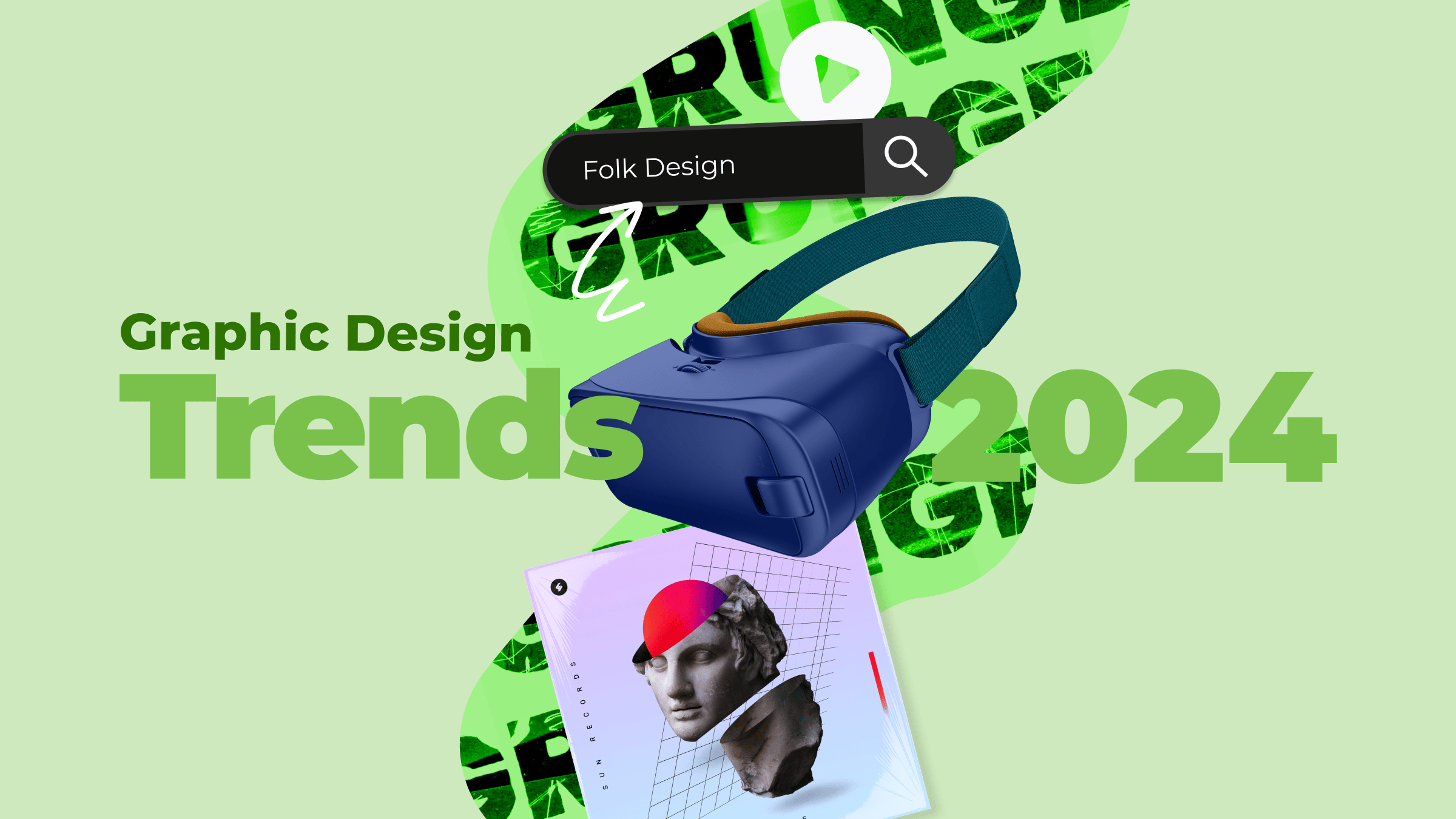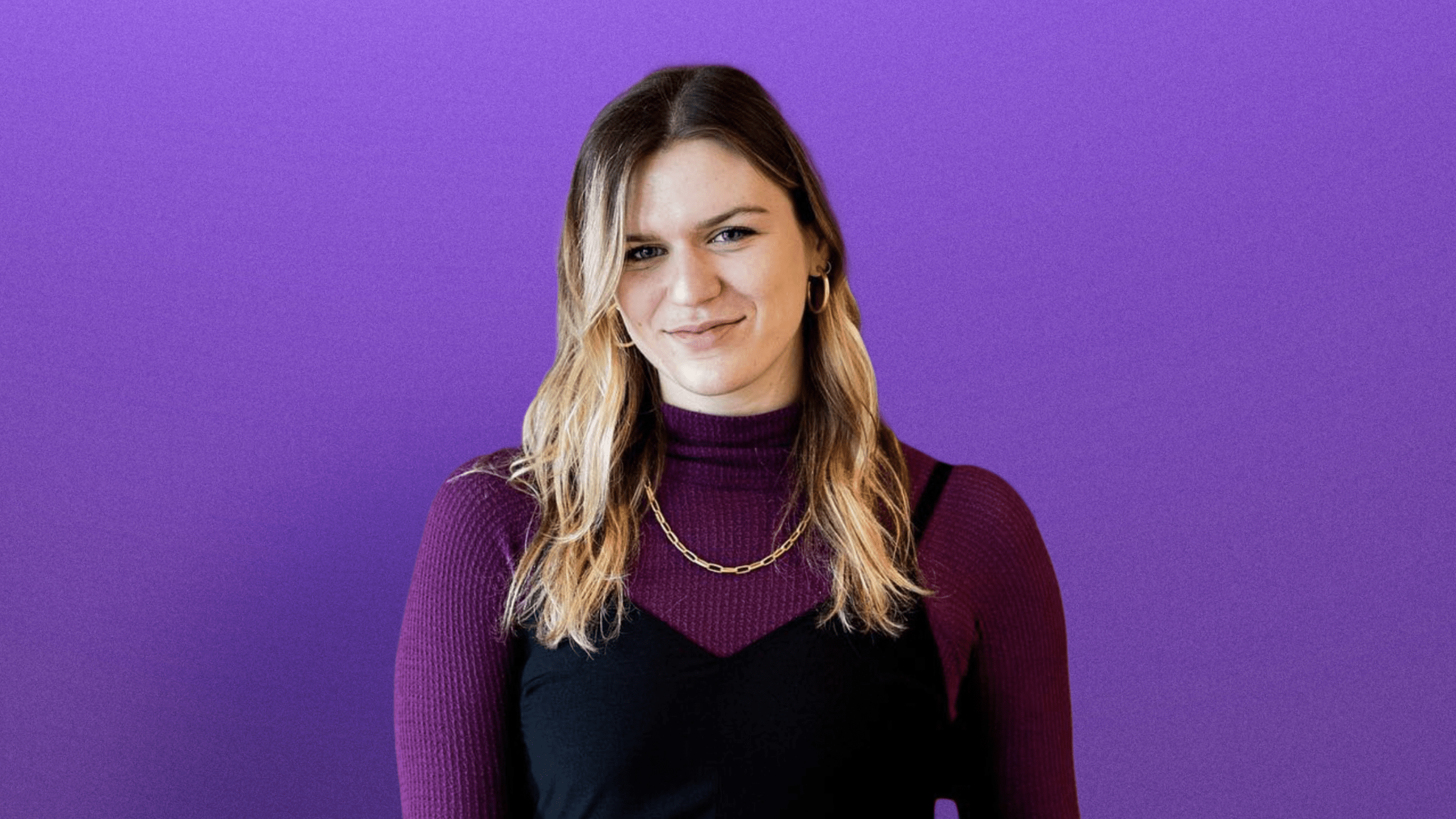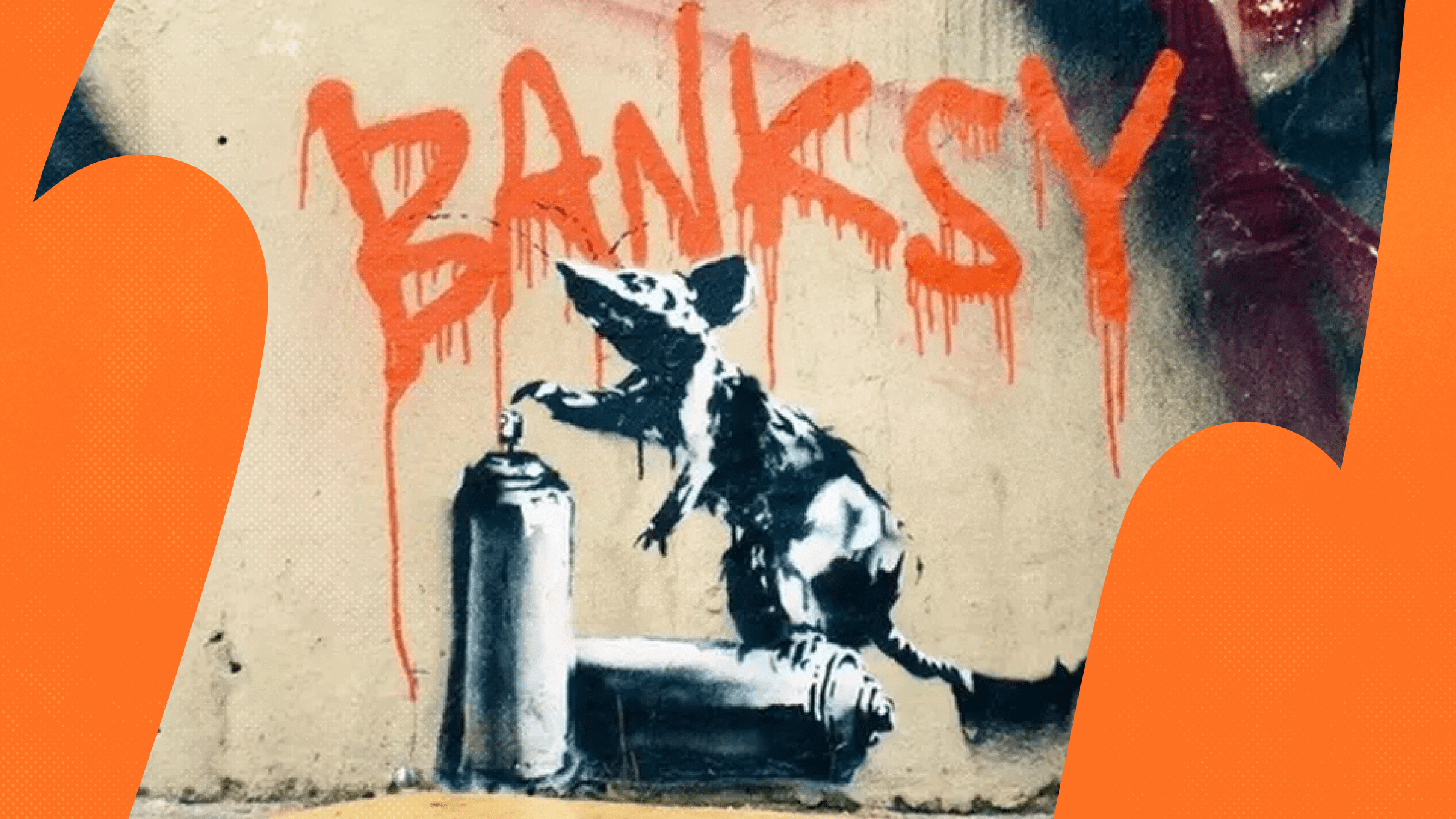Want to elevate your designs in the new year? Dive into the future of design and explore the top graphic design trends predictions for 2024.

In the ever-evolving world of graphic design, staying ahead of the creative curve is essential – for seasoned professionals and budding designers alike. Year to year, the design landscape is continually evolving based on new technologies, tools, and trends. And, as 2024 fast approaches, we’re on the precipice of some exciting new creative possibilities.
Whether you’re a designer looking for inspiration or a business owner revamping your branding, staying on top of trends is critical to staying ahead of the design game.
From multimedia and collage to interactive visual experiences, let’s explore the top graphic design trends our experts – including design icon Beci Orpin and designer Jacob Cass – predict will shape the design industry over the coming year.
1. Multimedia & Collage
Multimedia design and digital collage have taken the design world by storm over the last few years – and we’re not expecting them to fade anytime soon. This crafty trend invites graphic designers, illustrators, and digital artists to grab their virtual scissors and glue to combine mediums and ideas digitally. While collage is traditionally an analog art form, the rise of modern-day multimedia design has broadened its possibilities.
Melbourne-based multidisciplinary artist Beci Orpin is an expert at expressing her creativity through collage. Her work is described as quaint, feminine, and childlike, blending hand-drawn sketches with kids’ stickers, candy wrappers, fabric swatches, and international stamps. Her recently published Book of Girls is a masterpiece of collage art containing souvenirs, sketchbook scribbles, and various sources of inspiration she’s collected throughout her career.
“I love collage, and multimedia design – especially in illustration – has been something I’ve seen pop up a lot,” Beci says. “It’s fascinating and something I draw from in my work. I love taking something scanned, vector, and photographed and putting that all together. I’ve only done it in a tactile collage format, but you can definitely do it digitally with compositions.”
2. Animated Design
Say goodbye to static visuals because this graphic design trend is all about achieving attention-grabbing impact through movement. You can use animated design to breathe life into your creative projects, captivate audiences with engaging storytelling, and enhance user experiences. Whether a looping GIF – like this floral animation by artist Julia Chetwood – a subtle hover effect, or full-blown motion graphics, animation offers endless creative possibilities.
“There’s some great animation design happening at the moment,” Beci says. “I did a series of animations for Save the Children, but I’m keen to see more animated designs, learn more about animation, and make my work move.”
2024 is the year to use the power of motion to convey your message. Harness this dynamic trend by adding movement to logos, illustrations, or web elements to create more memorable and immersive experiences. Careful timing, fluid transitions, and visual coherence are critical to successful animated design, ensuring it doesn’t overwhelm but enhances the overall impact.
3. Interactive & Tactile Design
Whether digital or physical, we expect to see interactive and tactile design turning heads in 2024. This trend is particularly taking off for real-life retail experiences. More brands are using immersive installations to entice shoppers into their stores, like this colorful, textural exhibition made with recycled materials, inviting playful interactions in a public space.
“I’m seeing a lot more tactile and interactive design – digitally and physically,” Beci explains. “There are a lot more interactive things happening. The rise in interactive tactile design is like the return of in-person shopping – everyone was buying from the internet, and then big installations suddenly went up to get people back in the store. Or when video stores came out, people stopped going to the movies, and then everyone remembered how cool the movies were.
“After COVID, people want to experience and interact with things. I think the trend of creating experiences that are interactive and tactile is something that will continue to take off.”
Jump on this trend by incorporating tactile elements, responsive interfaces, or augmented reality features into your work. Whether it’s designing interactive infographics, kinetic logos, touch-responsive exhibits, or engaging multi-sensory experiences, look for ways to nurture real connections – whether that’s between brands and consumers or you and your audience.
4. Online Brand Guidelines
Traditional brand guidelines just aren’t cutting it anymore. To keep up with our fast-paced digital landscape, designers must respond with agility and real-time updates – which is why we’re seeing a shift to easy-to-share, digital style guides.
“Traditional brand guidelines are stuck in the past,” says Jacob. “Clunky physical brand books are collecting dust on the shelves, and low-res PDFs without version control float around in our inboxes. Digital style guides that can be updated on the fly will become more standardized as we move into 2024 and beyond.”
The rise of digital brand asset management tools and innovative solutions like Standards will only accelerate this trend. These purpose-built platforms enable a collaborative approach in which teams can instantly implement changes, ensure a consistent visual identity across all touchpoints, and maintain brand integrity.
5. Apple Vision
Want to add Apple Vision Pro to your graphic design toolbox in the new year? Seamlessly blending digital content with the physical world, Apple’s spatial computing device gives designers a powerful tool to create immersive experiences and explore new frontiers of creativity.
This headset allows wearers to interact with apps and digital content in a whole new way – we’re talking images that can expand to fill their environment, mixed-reality panoramas, and immersive entertainment.
But what does all this mean for graphic design? For one thing, the technology will make it possible to preview your work scaled-up and in situ – like an advertising poster on a giant billboard.
Meanwhile, Vision Pro makes it possible to navigate a complex Photoshop or Illustrator project in a 3D space, enabling a more efficient and intuitive design process. In addition, its eye- and hand-tracking capabilities could revolutionize how we create vector art.
“Apple Vision is a tool I expect designers to jump on in 2024,” says Envato’s Digital Design Manager, Keiron Lewis. “We’re not sure what this will look like at this stage, but as soon as people access the technology, we’ll see it explored. However, I also predict people will revolt against this high-tech newness, and we’ll see people lean more into traditional craftsmanship.”
6. Folk Design
What goes around comes around, and while the past few years have seen a resurgence of 90s and Y2K design trends, people are now rewinding to the 70s. That’s right – folk design is the future.
“I’m noticing a folk trend in graphic design,” says Beci. “My work had this same folk feel 10 to 15 years ago, and I’m seeing that resurface, which is interesting.”
Folk design celebrates simplicity, authenticity, and heritage, drawing inspiration from traditional arts and crafts. Folk design is all about telling a story and has the power to forge emotional connections with audiences and channel a sense of nostalgia. For example, this family-themed creation nods to old-school photo albums, intergenerational relationships, and the adage “Home is where the heart is.” Folk design also often incorporates a connection to land, which we see in these paper cut-outs of native spices.
This trend signals a charming departure from ultra-slick modern aesthetics, gaining popularity thanks to its authenticity. Today, designers use it to promote cultural identity and diversity, honor a rich tapestry of global traditions, and make their work more relatable.
7. Grunge
The resurgence of grunge is injecting a raw, edgy, and rebellious aesthetic into today’s graphic design landscape. This trend is rooted in the punk and alternative music scenes of the 1990s, embracing imperfection, distressed textures, and a distinctly DIY ethos. As a result, it signals a stark departure from the polished and minimalistic designs that have dominated in recent years.
We see grunge used in this whisky campaign by acclaimed American graphic designer and the “godfather of grunge,” David Carson. He gives the traditional label a chaotic collage look with the addition of hand-scrawled text and frantic paint textures.
And here, Carson rips up the rulebook again – quite literally – by playing around with distressed elements, such as rough edges and torn-paper effects. In addition, the muted, earthy color palette is a common grunge characteristic that gives designs a vintage, nostalgic vibe.
In an era where individuality is highly valued, this trend provides a unique and compelling way for designers to connect with audiences on a visceral level. But remember, grunge is truly remarkable when it strikes a balance between chaos and coherence.
8. AI Will Become More Accessible – But Won’t Replace Designers
AI image generators have officially entered the mainstream, and more graphic designers are experimenting with these tools to see what they can do.
For example, Jacob entered the same prompt into Midjourney and Dall-E. He got a flurry of pink-feathered flamingos – all served up in seconds – just by entering a short text description and clicking ‘generate.’ He’s also experimented with AI-powered photo editor Lensa to manipulate his portrait and develop ultra-realistic avatars.
“Although AI art generators such as Midjourney and Dall-E have been on the market for a few years now, they have not been as accessible or integrated into our workflow as they will be,” says Jacob. “With Adobe’s generative AI model, Adobe Firefly, now being integrated into Adobe’s (Beta) software, we can now generate AI imagery without the need for complex prompts. If you haven’t already, give Adobe’s innovative ‘Generated Fill’ feature a go!”
But that doesn’t mean graphic designers and other creative professionals will soon be out of a job. And according to Beci Orpin, the AI trend should be seen as an opportunity, not an obstacle. These tools can open up a range of time-saving and creativity-optimizing possibilities.
“AI seems to be what everyone’s talking about lately as people are experimenting with new tools,” says Beci. “I’ve played around with Midjourney and a few different programs to educate myself, and it feels like when Illustrator and Photoshop first came out. People were like, ‘Oh, anyone’s going to be able to become an illustrator or designer now,’ but it still takes a certain amount of skill, taste, and specific knowledge to become good at those things.
“AI art still has a definite look at the moment, so I don’t feel threatened by it. As long as the technology is used ethically, it will just be another great tool creatives can use. Designers should be intrigued and curious about it – not scared.”
Over the next few months, we expect more conversations about how to use this technology ethically and effectively to achieve design efficiencies. So what are you waiting for? See what you can achieve using AI today!
That does it for the graphic design trends we’re predicting for 2024. While you’re here, check out our full interviews with design experts Beci Orpin, Jessica Walsh, and Jacob Cass. Or head to Envato Elements to elevate your designs today!






















